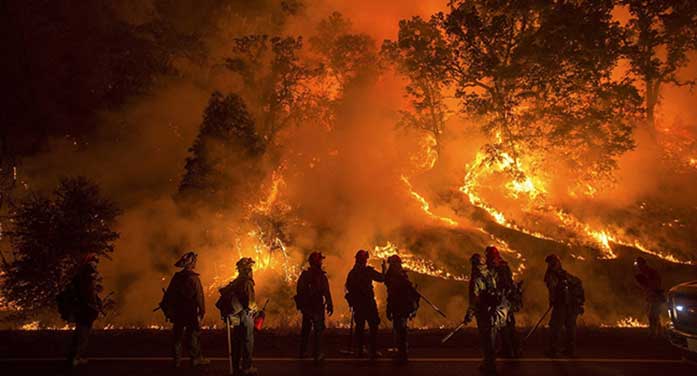The world’s eight most extreme wildfire weather years have occurred in the last decade, according to a new study that suggests extreme fire weather is being driven by a decrease in atmospheric humidity coupled with rising temperatures.

Mike Flannigan
“Extreme conditions drive the world’s fire activity,” said former University of Alberta wildfire expert Michael Flannigan, who conducted the research with study lead Piyush Jain, research scientist with Natural Resources Canada, and Sean Coogan, a postdoctoral fellow in the Faculty of Agricultural, Life and Environmental Sciences.
“For example, in Canada, just three percent of fires are responsible for 97 percent of the area burned.”
Flannigan, who joined Thompson Rivers University in August, explained the team examined extreme fire weather trends from 1979 to 2020 using common fire weather indexes that provide estimates for fire intensity and rate of fire spread, as well as changes in vapour pressure, or humidity.
“We looked at the extreme end of the distribution tail and asked, ‘Are there trends and elements that tell you how intense a fire is, how fast fire will spread?’ And indeed there are.”
Jain, who spent the better part of a decade as a U of A researcher, said the study links the trends in rising global temperatures and decreases in humidity to the likelihood that naturally occurring extreme fire events will happen more often, spread to new areas and burn more intensely than ever before in recorded history.
“This has important implications for fire management as well as public safety, particularly as we can expect even more extreme fire weather to occur with the further warming of the climate.”
In fact, decreasing relative humidity was a driver of more than three-quarters of significant increases in intensity and fire spread, and increasing temperature was a driver for 40 percent of significant trends.
The study also found significant increases in extreme weather that can cause major fires in close to half of the Earth’s burnable landmass – including in Northern Canada and British Columbia.
Flannigan said regions around the world have almost universally witnessed an increase in extreme weather in the past 40 years, with marked increases in the last two decades.
“It’s not a big surprise, but with climate change, we expect warmer conditions to continue and this trend to continue, expand and get worse.”
In British Columbia, for instance, Flannigan said three of the last five fire seasons – 2017, 2018 and 2021 – are the three worst on record.
As well, that province has seen an uptick in pyrocumulonimbus, or fire-generated thunderstorms that consist of thousands of lightning strikes. In the midst of B.C.’s devastating 2021 wildfire season, one such storm hurled down more than 700,000 bolts in an evening.
“Interestingly, human-caused fires are going down, but lightning-caused fires are increasing and more than compensating,” said Flannigan.
And living with wildfire also means living with the consequences of fire. The recent flooding that is crippling land travel in and out of B.C.’s lower mainland is a good example, Flannigan said.
“It is not all attributable to fires, but fires do play a role. When you remove the vegetation, the rain is not being intercepted by the trees, the roots aren’t picking up the moisture, there is nothing to give the soil stability – you’re much more likely to see land- and mudslides in burnt areas.
“This has been documented in California for years.”
He noted even if global warming stopped tomorrow, the wildfire threat would continue to loom large for decades, so communities need to prepare for all wildfire eventualities.
“We’re on this path of a new reality. It’s not normal because there’s nothing normal about what’s going on.”
With that in mind, Flannigan, who conducted the research as part of the U of A’s Department of Renewable Resources, said communities need to have an emergency management plan for all other disasters. As well, programs like FireSmart Canada are available to help homeowners and communities protect themselves.
“We can’t make them fireproof, but we can make them more resilient. We have to learn to live with fire; we’re not going to get rid of it.”
The study, “Observed increases in extreme fire weather driven by atmospheric humidity and temperature,” was published in Nature Climate Change. The co-authors of the study also include Dante Castellanos Acuna, a U of A renewable resources postdoctoral fellow, and John Abatzoglou, an environmental engineering researcher from the University of California.
| By Michael Brown
Submitted by the University of Alberta’s Folio online magazine. The University of Alberta is a Troy Media Editorial Content Provider Partner.
© Troy Media
Troy Media is an editorial content provider to media outlets and its own hosted community news outlets across Canada.


